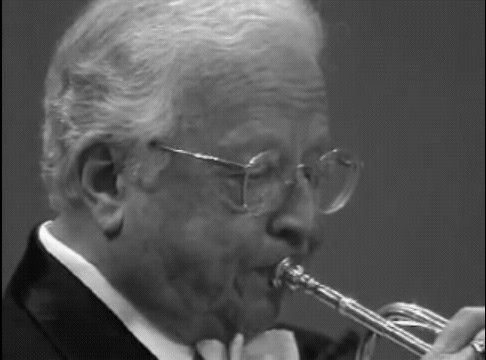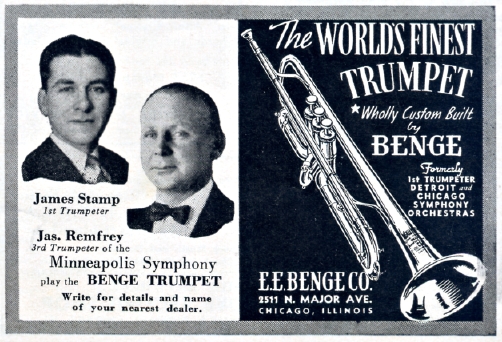
young Freddie Hubbard ca 1962
Adolph Herseth -
principal trumpet Chicago Symphony
Miles DavisAdolph Herseth - intro to Mahler 5
Freddie Hubbard - The Night Has a Thousand Eyes Freddie Hubbard - Straight Life Miles Davis Miles Davis - So What
Learning the Trumpet
Learning to teach yourself is most important.
Practice sounding good. Do not play something wrong over and over again! Slow down the tempo until you can play it with the correct notes, in tune, and in rhythm. Listen to how it sounds. Play melodies out of fake books or etude books or by ear. Playing melodies makes it real obvious if it is out of tune or has a bad sound. Play along with recordings.
If your practice starts sounding worse then rest (for a few minutes, hours or day). Do not think about it while resting. Do something else. Try again later - it almost always sounds better.
Players, Teachers
Perfection - Tine Thing Helseth with Det Norske Kammerorkester, notice the complete lack of any muscle tension The Berliner Philharmoniker perform Stravinsky's Petrushka / Trumpet tutorial Bud Herseth Lesson Notes Bud Herseth more info Pencil Exercise - G Rawlin Pat Harbison, Karl Sievers Bill Moriarity talking about Roy Stevens and the history of the Stevens-Costello method Warren Vache On Embouchure Lesson The Balanced Embouchure YouTube - Trumpet Lesson 4 - Zero Pressure technique Lynn Nicholson - can scream without forcing it Bill Adam - Great Teacher Bill Adam The Other Side of the Bell � A Trumpet Podcast; Episode #15: Bill Adam Tribute Chris Botti Interview with Mr Adam William Adam & Greg Wing play the "Routine" by GWing
Jimmy Stamp

Jimmy Stamp on youtube Stamp Upper Register Etudes Player/Horn Combinations
Trumpets
Benge Serial Numbers 5/64 hexkey for bach strad stop rod Bach Strad Bells Bach Stradivarius Bell Variations Early Elkhart Serial numbers Bach Strad Leadpipes Bells - Harrelson Bachloyalist.com Bach trumpet serial numbers Bach Stradivarius Models - TrumpetMaster Dave's Bach Trumpet Page Besson Trumpets Yamaha Schilke Clones YAMALLOY - older yamaha trumpets may have valve problems Guide to new trumpets Schilke Serial Numbers Kanstul Model Comparison List
Valve Aignment At Home?
Mouthpiece
Bach Mouthpiece bach loyalist Bach Mouthpiece Manual Bach Mouthpiece history "Vincent Bach Corp, no dot, mouthpieces are essentially Mt Vernon pieces and EVERYTHING about them is different from subsequent eras. Exceedingly comfortable rims with just the right bite, more open and balanced throat and backbores standard (not designated as such), a makeup of brass that resonates like no other. Every one I've played has been remarkable and very few modern copies seem to be able to capture what makes them special."Alpha Angle Warburton Trumpet, Cornet and Flugelhorn Mouthpieces Stork Trumpet Mouthpieces Stork Specs Stork Comparison Kanstul.com Gustat Mouthpiece Bach - Schilke Mouthpiece comparison chart Mouthpiece comparison chart Schilke Mouthpiece model descriptions Holton Heim Mouthpiece vs stork vacciano.url Kanstul Mouthpiece Comparator - superimposes trumpet mouthpiece profiles B = Elkhart Bach BMV = Mt Vernon Bach BNY = New York Bach GIR = Giardinelli S = Schilke W = Warburton M = Monette BFL = (Modern) Bach flugelhorn CG = Claude Gordon G = Gustat P = Parduba Bob Reeves RimsBackbore ComparatorBob Reeves cup size versus bore S - Shallow bowl shape #28 Bore M - Medium bowl shape #27 Bore D - Medium deep, conical bowl shape #26 Bore C - Medium deep bowl shape (like Bach 3C) #26 Bore Bob Reeves Rims 40 - Semi-flat with a medium-sharp bite. Functionally similar to Bach Mount Vernon 10 1/2C, Bach 11 3/4 C, 17, and Schilke 6 rims. 41 - Semi-flat with a medium-sharp bite. Functionally similar to Bach 7C, 9D, 10 3/4 A,11A, 11C, and Schilke 13-4 rims. 42 - Medium-round with a soft bite. Functionally similar to Bach Elkhart 3C & 6C, Bach 8C, 10B, and Schilke 14 rims. 43 - Semi-round with a soft bite. Functionally similar to Bach 2 3/4 C, 3, 3E, 3F, and Schilke 16 rims Bob Reeves backbore 692s A very efficient backbore. It causes the mouthpiece to be physically shorter than our conventional mouthpiece. When combined with shallow cups, it makes the upper register very efficient. When combined with very deep cups (like a "B" cup) it allows the darkness in sound of the cup while continuing to assist in the upper register. 2 Our standard backbore. More centered than a Bach #10 with excellent tone color and intonation. This backbore works well on all of our cups. It was the 2nd backbore Bob ever made. 69 Good for big band playing. Records well; bright, focused sound. This is very popular on our shallower cups (S and shallower). Good if you like to "power" the upper register. It was named because Bob developed it in 1969. 692 Darker and broader tone than our 69 backbore. Works great for those players who "power" the upper register. It is a combination of both our #69 and #2 backbore and thus the name, 692.
Mouthpiece Throat Size (bore) Throat Size wire inches gauge decimal mm 28 0.1405 3.569 27 0.144 3.658 26 0.147 3.734 25 0.1495 3.797 24 0.152 3.861 23 0.154 3.912 22 0.157 3.988 21 0.159 4.039 20 0.161 4.089Mouthpiece Gap
Mouthpiece gap on vintage Benges Benge Gap Benge 3X Question, Problem Harrelson Shim Kit Harrelson Mouthpiece Gap Solutions Venturi & Shim Demo Video Jason Harrelson Warburton Mouthpiece Gap GR mouthpiece gap Bob Reeves Gap info Improving the upper register with the correct gap If your mouthpiece gap is greater than the optimal gap, you will have a bit more resistance, although the horn will slot and speak well. Lower register may become stuffy, upper register may reach a "wall", above which resistance can not be overcome.
If the gap is less than optimal, you will have less resistance, as well as difficulty slotting (less distance between the slots), poor definition to the notes above high C,
Lower register very free-blowing,
Lack of healthy resistance causes upper register to "airball", or wash out
There is nothing to "lean on" when coming back down from a high passage
Here is the GR Mouthpiece formula for calculating the optimal gap.
the exit wall thickness of the mouthpiece shank multiplied times 5
plus
the leadpipe internal diameter minus the receiver internal diameter multiplied by .75
Example:
exit wall thickness of mouthpiece = .021"
X 5 = .105"
leadpipe internal diameter is .345" and receiver internal diameter is .385.
.385 - .345 = .040
.040 X .75 = .030
.105 + .030 = .135 Optimal Gap
Warburton makes it more simple: "The optimal gap is usually somewhere between 0.100 and 0.150 inches "
Harrelson says optimal gap usually between .060 and .100 inches.
The great Clifford Brown said 1/8 inch, .125"
Bob Reeves emphasizes differences in players, rather than equipment affecting the optimal gap, and sells 3 piece mouthpieces that give different gaps with different sleeves.
Some outrageously good players use no gap. A Flugelhorn has no gap. Some players are successful with gaps much greater than 1/4 inch. If you are getting good results there is no need to change the gap. Leave it alone!
A change of .001" of the mouthpiece shank diameter will cause a difference of about .020" in the gap distance.Gap Size fraction Decimal mm 3/32" 0.09375 2.38125 7/64" 0.109375 2.778125 1/8" 0.125 3.175 9/64" 0.14062 3.571875 19/128" 0.14844 3.7703 5/32" 0.15625 3.96875